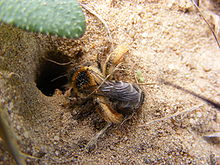- Dasypodaidae
-
Dasypodaidae Dasypoda altercator Scientific classification Kingdom: Animalia Phylum: Arthropoda Class: Insecta Order: Hymenoptera Suborder: Apocrita Superfamily: Apoidea Family: Dasypodaidae Subfamilies Dasypodainae
Promelittinae
SambinaeThe family Dasypodaidae (originally named "Dasypodidae", although that name had already been taken) is a small bee family, with more than one hundred species in eight genera[1], found in Africa and the northern temperate zone, primarily in xeric habitats.
They are typically small to moderate-sized bees, with shaggy scopae, and are commonly oligolectic. All members of this family have two submarginal cells in the forewing.
Taxonomy
Historically, they have been considered a subfamily within the family Melittidae, but recent molecular studies indicate that Dasypodaids are not only ancestral to them, but in fact are the sister taxon to all other bees.[2]. The largest genus, Hesperapis, contains some 40 known species, plus several more undescribed, with an unusual disjunct distribution in North America and southern Africa.
The family Dasypodaidae groups the following subfamilies and genera[1]:
- Subfamily Dasypodainae
- Dasypoda
- Eremaphanta
- Capicola
- Hesperapis
- Subfamily Sambinae
- Haplomelitta
- Samba
- Subfamily Promelittinae
- Promelitta
- Afrodasypoda
References
- ^ a b Michez D. (2008)Monographic revision of the melittid bees (Hymenoptera, Apoidea, Melittidae sensu lato). Proc. Neth. Entomol. Soc. Meet. 19: 31-39.
- ^ Danforth, B.N., Sipes, S., Fang, J., Brady, S.G. (2006) The history of early bee diversification based on five genes plus morphology. Proceedings of the National Academy of Sciences 103: 15118-15123.
- C. D. Michener (2000) The Bees of the World, Johns Hopkins University Press.

This bee-related article is a stub. You can help Wikipedia by expanding it. - Subfamily Dasypodainae

